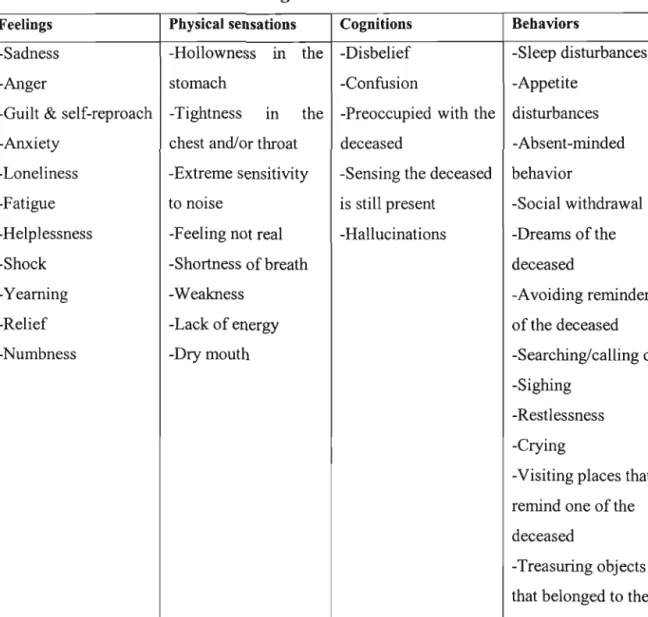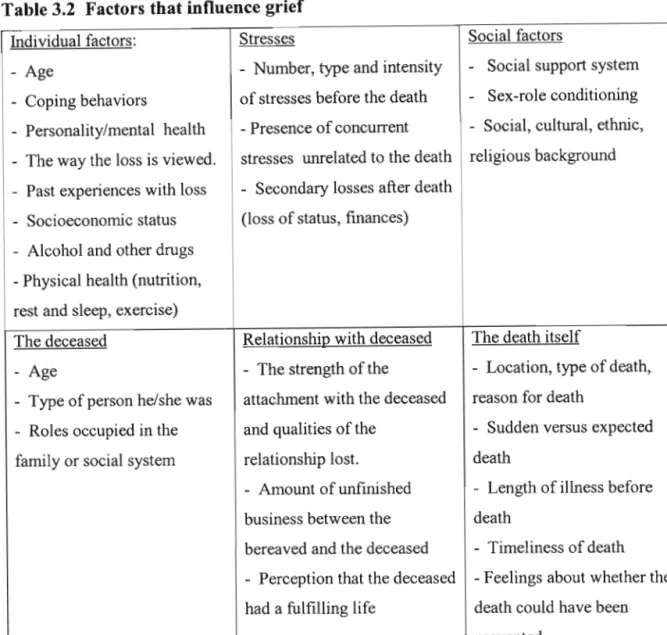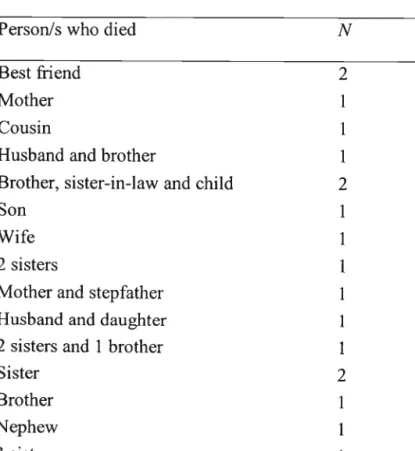There are local and national guidelines for dealing with AIDS bereavement. Further research on AIDS bereavement in the context of South Africa needs to be done, taking into account the scale of loss and bereavement due to AIDS and the lack of domestic information on the issue.
The Impact of an AIDS-Related Death 223
Coping 244
Introduction
Research problem
Interventions tailored to the South African context need to be developed to address the needs of those who have lost loved ones to AIDS in the past, as well as those who will lose loved ones in the future. In the coming era of antirheumatic drug treatment in South Africa, social workers may need to help individuals come to terms with the fact that their loved ones succumbed to AIDS before they could benefit from these treatments, as well as help those who will be bereaved in the future the loss of loved ones who did not respond to these treatments.
Research Questions
But the spread has been extremely slow until now, and most people infected with HIV still do not have access to these treatments ("South Africa must face the truth about HIV mortality. According to the 2001 census, the total population of South Africa is 44.8 million people (Statistics South Africa, 2003).
Conceptual Framework
Second, the study of AIDS-related bereavement should address the multidimensional and complex nature of the human environment. Thus, this study examined the nature of AIDS-related bereavement among individuals through qualitative interviews.
Definition of Terms
Based on the findings of this study, strategies are suggested to address AIDS-related bereavement at various levels (eg, individual, community, government) and through various means. This appears to be the most appropriate framework to use for studying AIDS-related bereavement in South Africa, taking into account the unique local context.
Outline of Chapters
The conceptual framework of the study is briefly described, followed by a list of terms used in this study. Chapter six consists of a description of participants in the primary sample in the form of brief profiles, followed by a summary of participants' demographic characteristics and the nature of their losses.
PART TWO: LITERATURE REVIEW
The HIV/AIDS Epidemic in South Africa
AIDS Epicentre
Demographics
KwaZulu-Natal, traditionally considered the country with the highest HIV prevalence (based on data from antenatal clinics), ranked only fourth with about 11.7% infected. HIV prevalence was higher among those living in urban informal settlements than in urban formal settlements and in rural areas.
AIDS Mortality
The most important finding was that AIDS had become the leading cause of death in South Africa, and it was estimated that 40% of all adult deaths between the ages of 15-49 were now due to HIV/AIDS. To get a sense of the severity of the AIDS crisis in South Africa, we can compare the AIDS death rate in South Africa with that of the United States.
Contributing Factors
The return of soldiers from military bases in areas of high HIV prevalence also likely contributed to the rapid spread of the epidemic in South Africa (Dorrington & Johnson, 2002). Campbell provided a refreshingly honest and sober assessment of the difficulties inherent in developing HIV prevention programs in the South African context.
Conclusion
According to the psycho-social-environmental model, all potential contributing elements must be addressed simultaneously. Before we explore what it's like to experience AIDS grief, we need to have a basic understanding of grief and grief in general.
An Overview of Grief and Bereavement
The Western Perspective
The first volume was published in 2002 and focused on death and loss in 11 major religious traditions. This was followed in 2003 by the second volume which focused on death and bereavement in the Americas, which included the following countries: USA, Canada, Mexico, Jamaica, Panama, Colombia, Brazil, Peru, Argentina and Venezuela.
Genesis of Bereavement Theory
Bowlby (1980) suggested that grief was related to the attachment that the bereaved continued to feel for the deceased. This means that the times when the bereaved will be focused on thoughts about the loss (eg, longing for the deceased, crying, looking at old photos, or imagining things the deceased might have said) are loss-focused coping.
Manifestations of Normal Grief
Factors Influencing Grief
Age - Number, type and intensity - Social support system - Coping with stress before death - Gender role conditioning - Personality/mental health - Presence of concurrent people - Social, cultural, ethnic - The way the loss is viewed. Roles occupied in the and qualities of the - Sudden versus expected family or social system relationship are lost.
Anticipatory Grief
It is important to remember that individuals can experience many reactions in anticipation of the death of a loved one and we must be sensitive to this. Arguing whether this phenomenon makes adjustment after death easier or more difficult is of little practical value.
Complicated Grief
Delayed grief is when the individual has an emotional response at the time of the loss, but it is insufficient. The individual may experience physical symptoms similar to those of the deceased before he/she died (Worden, 1991).
Disenfranchised Grief
Controversial Issues
There is consensus in the grief literature that context plays an important role in influencing the grieving person's response to loss (Stroebe & Schut, 1999; Klass, 1999; Neimeyer, 1998). It should be noted that the use of certain terminology in the field of bereavement has also been somewhat problematic.
Recent Developments
They discovered that once the acute pain of grief subsided, participants engaged in deep introspection, resulting in personal growth. Further research is needed to understand the role of personal growth in grief (Hogan, Morse & Tason, 1996).
AIDS-Related Bereavement
Applying Findings from Different Contexts
Third, the cultural environment is very different between developed and developing countries, for example in terms of the perception of the cause of AIDS and the role of the extended family in caring for the sick. But Freeman concluded that despite the limited applicability of much research to developed countries, "to ignore existing knowledge would be short-sighted" (p. 145).
Prevalence of AIDS-Related Bereavement
But the AIDS epidemic in South Africa is on a much larger, more complex and overwhelming scale than that witnessed anywhere else in the world. Freeman identified two macro-level concerns for South Africa in the future as a result of people dying of AIDS.
Factors Influencing Bereavement Due to AIDS
The high AIDS-related mortality rate has also exposed countless children in South Africa to the death of parents, family members and neighbors. The high number of AIDS-related deaths in South Africa has created a parallel epidemic of mourners grieving the loss of loved ones to AIDS.
PART THREE: METHODOLOGY
This chapter describes the research methodology used in the study and my rationale for choosing a qualitative paradigm. This is followed by a discussion of the sampling process, data collection and analysis procedures, ethical concerns, and challenges that come with this type of study.
Research Design
However, my choice to use qualitative methods was mainly determined by the nature of the research problem I wanted to investigate. Before I go any further, I would like to make a comment about the role of literature review in qualitative research.
Sample
In my case, I realized from my review of the literature that very little was known about AIDS-related bereavement in the South African context, so this was helpful in this regard. Due to the stigma and secrecy surrounding HN/AIDS in South Africa, I was concerned about my ability to recruit participants who would be willing to share their experience.
Data Collection
I reiterated the purpose of the study and expressed my desire to learn more about their experiences of AIDS and bereavement in the context of South Africa. During the interviews, I kept in touch with the participants to check how they were doing and to remind them of the next meeting.
Recording of Data
They were of a less personal nature and focused more on informants' experiences and attitudes towards caring for people affected by HIV/AIDS. The primary purpose of these notes was to record my emotional response to the interviews (including my thoughts, feelings, biases and sensations) and to help me analyze material as it developed.
Analysis of Data
In the transcripts and field notes, code names were assigned to statements that highlighted particular aspects of the participants' grief experience. Following the coding procedures outlined by Strauss and Corbin (1998), phenomena were grouped into categories of similar importance, and the content of the categories was compared between and within interviews.
Ethical Considerations
Thus, the participants were informed about the possible risks and benefits associated with participation in I ensured that participants were debriefed at the end of each interview and at the conclusion of the interview.
Challenges Presented by the Study
During the data collection process, I quickly became aware of the unique life circumstances of AIDS mourners in the context of South Africa compared to those in the United States. I was also aware of the potential of the participants to tell me what they think I want to hear or to present themselves or inform in a certain way because they didn't know if they could trust me to be who I am.
Study Participants
Profiles
Nomusa: Nomusa, a 30-year-old Zulu woman, discovered she was HIV positive when she was 21 years old. She had three children who were HIV negative and was very unhappy in her marriage.
Demographic data
The stress she was constantly under was affecting her health and she was very worried. She felt closest to her sister with whom she lived and relied heavily on her for support.
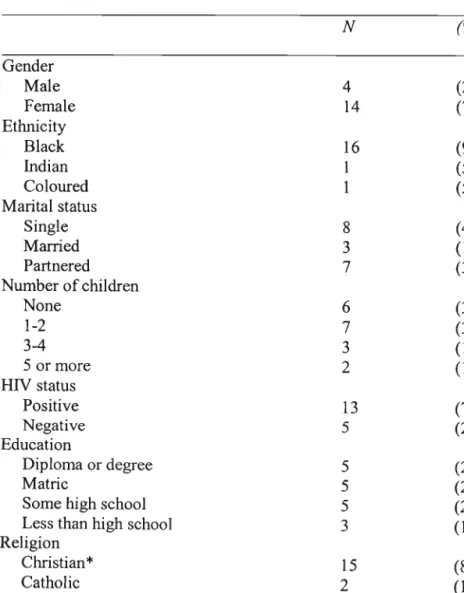
PART FOUR: ANALYSIS AND DISCUSSION
Poverty
The Social and Economic Context of AIDS
In addition, we see the following: significant numbers of children have been orphaned by AIDS, many older people have been forced to become the primary caregivers of children who have lost their parents or other family members to AIDS, and households have been crippled financially due to AIDS-related illness and death.
Different Priorities for the Bereaved in South Africa
South Africa is one of the most unequal societies in the world (Johnson & Budlender, 2002; UNISA, 2000). Several studies have reported on the impact of AIDS-related deaths on the physical well-being of the elderly, including studies in Zimbabwe (Mupedziswa, 1997), Thailand, (Knodel, Saengtienchai, Im-Em & VanLandingham, 2001) and Tanzania (Appleton, 2000 ).
Children
Children Bereaved by AIDS
The plight of children orphaned by AIDS in Africa has received considerable attention in the popular press and to some extent in scientific journals. It was one of the first books to describe the experiences of children orphaned by AIDS in Africa.
Mental Health of Children Bereaved by AIDS
In fact, Wild (2001) conducted a review of the available literature on the psychosocial adjustment of AIDS-orphaned children, but she was unable to find many studies on this important issue. This book provides a somewhat brief but informative overview of the problems facing all those involved in helping children orphaned by AIDS in the US.
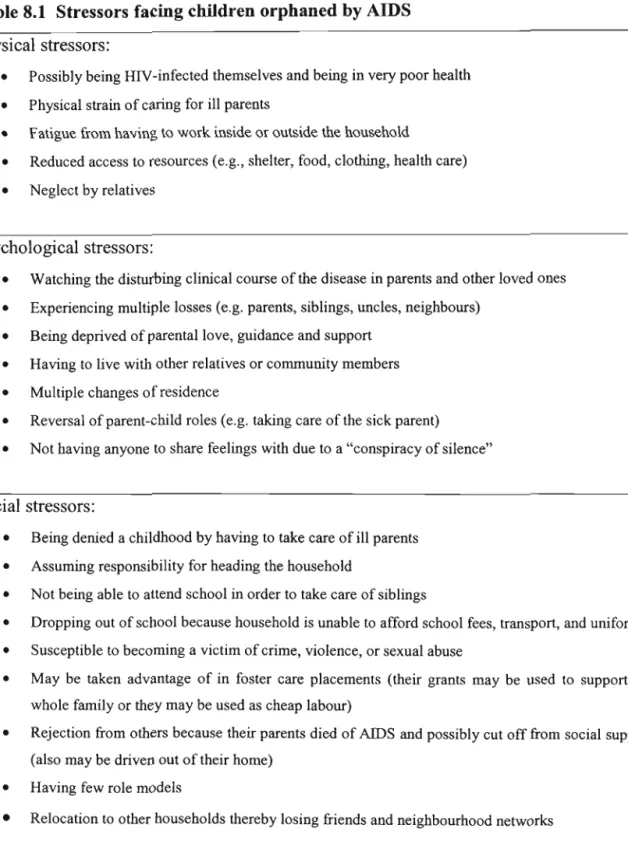
Worries about the Future Welfare of Children
Nomusa recalled when she was told her six-month-old daughter was also HIV-positive. Zanele acknowledged that she was not afraid of dying, but she was worried about what would happen to her six children because her parents were "very old and they will be gone soon." She was angry with her husband who had abandoned her and her six children.
Reason for Living
Sizakele also expressed anger at her husband, who she said she could not rely on to care for her children in the event of her death. 34; For Prudence, she knew she could rely on her mother to raise her child, but she worried about what would happen if her mother died.
The Final Days
Awareness Contexts
The brother refused to tell Mthoko himself that he was HIV positive: "He didn't want to talk about it." Still clinging to the belief that he might be HIV negative, Azon said, "I want to go back and get tested."
Relationship with the Deceased
It can refer to the love between the person and the deceased and the fact that the presence of the deceased was so profound that life without him seems unimaginable. The deceased can also be considered central if they were a vital source of day-to-day support, not only emotionally but also physically (e.g. day care).
Quality of Health Care
Since the mid-1980s, there has been a steady stream of research studies, most of them conducted in the United States, examining the attitudes of health care professionals toward people with HIV/AIDS. Enormous burdens are placed on the public health system (Walker, Reid, & Comell, 2004).
Palliative Care
This model of care shows promise as a cost-effective way to meet the palliative care needs of dying AIDS patients (Uys & Hensher, 2002). But there are enormous challenges facing community health care providers, including providing palliative care in the midst of abject poverty (Uys, 2003).
Family Caregiving Experience
But Monica was still concerned that her best friend's mother could become infected as a result of caring for her daughter: "She had no gloves on and had blood on her. Few studies have examined the experiences of families caring for a loved one who is dying of AIDS.
Not Anticipating the Death
And that's when it hit me: 'You know what, this guy's not going to make it - he's going to die.'''' She didn't talk to anyone about this feeling because she felt she had to be strong for her family. . She told my mum to go to bed 'cause you have to get up early tomorrow morning'. She was happily sending them all to bed, so I jokingly said, "What about me?" She said, 'No, you sit here with me.' But no one left.
The Funeral
Finally, one of the nurses went into the office and "checked the books and came up and told me he had passed away." It was done in a very matter-of-fact manner. There is a need for studies in the South African context that examine the comfort of professional caregivers (doctors, nurses, social workers) in working with dying AIDS patients.
